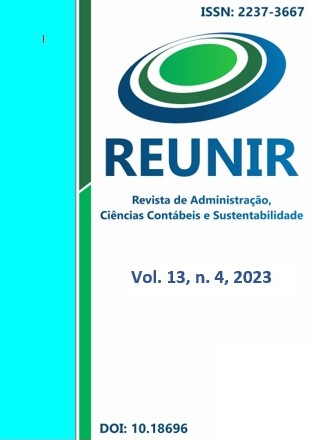Consumers' Perceptions of Green Advertising by Consumer Goods Companies
DOI:
https://doi.org/10.18696/reunir.v13i4.1458Keywords:
Green advertising, Cognitive responses, Instagram®Abstract
This article aimed to analyze and classify comments from Instagram® users after exposure to ecological advertisements of sustainable companies, according to the Cognitive Responses Theory. We used a qualitative approach to analyze comments on posts of six sustainable consumer goods companies operating in Brazil, totaling the analysis of 212 comments through coding. Thus, the study indicates that 86.4% of the cognitive responses of users, when commenting on the companies' green advertisements, were classified as supportive arguments and, among these, 82.6% were oriented to the message conveyed. In contrast, when analyzing the counterarguments, it can be seen that most responses referred to the product (63.1%). This shows that the target audience has a positive view of ecological advertisements, provided that the companies that perform Green Marketing offer quality products/services and reinforce the message conveyed. The research approach and method used can be replicated in different studies, considering the relevance of social media for the corporate image and strategic positioning of sustainable companies.
Downloads
References
Amoako, G. K., Dzogbenuku, R. K., Doe, J., & Adjaison, G. K. (2020). Green Marketing and the SDGs: emerging market perspective. Marketing Intelligence & Planning.
Belch, G. E., & Belch, M. E. (2014). Propaganda e promoção: uma perspectiva da comunicação integrada de Marketing (9a ed.). São Paulo: McGraw-Hill.
Bhat, V. N. (1993). Green Marketing Begins with Green Design. Journal of Business & Industrial Marketing, 8(4), 26–31. DOI: https://doi.org/10.1108/08858629310047243
Boyd, D., & Crawford, K. (2011). Six provocations for big data. In A decade in internet time: Symposium on the dynamics of the internet and society.
Briñol, P., Petty, R. E., & Tormala, Z. L. (2004). Self-validation of cognitive responses to advertisements. Journal of Consumer Research, 30(4), 559–573. https://doi.org/10.1086/380289
Corporate Knights. (2021). 2021 Global 100 ranking. Recuperado de https://www.corporateknights.com/reports/2020-global-100/2020-global-100-ranking-15795648/
Creswell, J. W. (2014). Investigação qualitativa e projeto de pesquisa: escolhendo entre cinco abordagens. Sao Paulo, Penso Editora LTDA.
Campos, S. A. P., Palma, L. C., Neutzling, D. M., Zucatto, L. C., & Slongo, L. A. (2013). A comunicação verde fala por si? Efeitos na identidade corporativa e propensão de compra. Revista Eletrônica de Ciência Administrativa, 12(2), 191-204. DOI: https://doi.org/10.5329/RECADM.2013016
Cruvinel, I. B., de Sousa, G. F. P., dos Santos, E. L. X., de Jesus, R. S., de Castro, P. R., de Sousa, A. C., ... & Feliciano, J. D. C. (2020). Marketing Verde: uma perspectiva bibliométrica da produção brasileira. Brazilian Journal of Development, 6(7), 45479-45498.
Dangelico, R. M., & Vocalelli, D. (2017). “Green Marketing”: An analysis of definitions, strategy steps, and tools through a systematic review of the literature. Journal of Cleaner Production, 165, 1263–1279. DOI: https://doi.org/10.1016/j.jclepro.2017.07.184
Davis, J. J. (1993). Strategies for environmental advertising. Journal of Consumer Marketing, 10(2), 19–36. DOI: https://doi.org/10.1108/07363769310039102
Endo, A. C. B., & Roque, M. A. B. (2017). Atenção, memória e percepção: uma análise conceitual da Neuropsicologia aplicada à propaganda e sua influência no comportamento do consumidor. Intercom: Revista Brasileira de Ciências da Comunicação, 40(1), 77-96. DOI: https://doi.org/10.1590/1809-5844201715
Enoki, P. A., Adum, S. H. N., Ferreira, M. Z., Aureliano, C. A., Valdevino, S. de L., & Silva, A. A. (2008). Estratégias de Marketing Verde na percepção de compra dos consumidores na grande São Paulo. Jovens Pesquisadores-Mackenzie, 5(8).
Fuchs, C. (2018). Propaganda 2.0: Herman and Chomsky’s propaganda model in the age of the internet, big data and social media. In Pedro-Carañana, J., Broudy, D. & Klaehn, J. The propaganda model today: Filtering perception and awareness (Vol. 8, pp. 71-92). University of Westminster Press.
Giacomini Filho, G. (2019). Ecopropaganda. São Paulo: Editora Senac.
Gil, A. C. (2010). Como elaborar projetos de pesquisa (5a ed.). São Paulo: Atlas.
Grewal, D., Bart, Y., Spann, M., & Zubcsek, P. P. (2016). Mobile advertising: A framework and research agenda. Journal of Interactive Marketing, 34, 3-14.
Groening, C., Sarkis, J., & Zhu, Q. (2018). Green Marketing consumer-level theory review: A compendium of applied theories and further research directions. Journal of Cleaner Production, 172, 1848–1866. DOI: https://doi.org/10.1016/j.jclepro.2017.12.002
Guimarães, A. F. (2006). Marketing Verde e a propaganda ecológica: uma análise da estrutura da comunicação em anúncios impressos (Tese de doutorado). Universidade de São Paulo, São Paulo, Brasil.
Khandelwal, U., & Bajpai, N. (2011). A study on green advertisement and its impact on consumer purchase intention. Journal of Creative Communications, 6(3), 259-276. DOI: https://doi.org/10.1177%2F0973258613491661
Kong, Y., & Zhang, L. (2012). When does green advertising work? The moderating role of product type. Journal of Marketing Communications, 20(3), 197–213. DOI: https://doi.org/10.1080/13527266.2012.672335
Kotler, P., & Armstrong, G. (2007). Princípios de Marketing. New Jersey: Pearson Prentice Hall.
Kotler, P., & Keller, K. L. (2006). Administração de Marketing: a bíblia do Marketing (12a ed.). São Paulo: Pearson.
Kozinets, R. V. (2015). Netnography: redefined (2a ed.). Newbury Park: Sage.
Kumar, P. (2017). Intents of green advertisements. Asia Pacific Journal of Marketing and Logistics, 29(1), 70-79. DOI: https://doi.org/10.1108/APJML-03-2016-0044
Kumar, V., and S. Gupta. 2016. “Conceptualizing the Evolution and Future of Advertising.” Journal of Advertising, 45, 302–317. DOI: https://doi.org/10.1080/00913367.2016.1199335
Lee Burton, J., Gollins, J., McNeely, L. E., & Walls, D. M. (2018). Revisting the Relationship between Ad Frequency and Purchase Intentions. Journal of Advertising Research, 59(1), 23-39. DOI: https://doi.org/10.2501/jar-2018-031
Lock, I., & Ludolph, R. (2020). Organizational propaganda on the Internet: A systematic review. Public Relations Inquiry, 9(1), 103-127.
Luo, B., Sun, Y., Shen, J., & Xia, L. (2020). How does green advertising skepticism on social media affect consumer intention to purchase green products? Journal of Consumer Behaviour, 19(4), 371–381. DOI: https://doi.org/10.1002/cb.1818
McDaniel, S. W., & Rylander, D. H. (1993). Strategic green Marketing. Journal of consumer Marketing, 10(3), 4-10. DOI: https://doi.org/10.1108/07363769310041929
Mostafa, M. M. (2009). Shades of green: A psychographic segmentation of the green consumer in Kuwait using self-organizing maps. Expert Systems with Applications, 36(8), 11030-11038.
Nielsen. (209). Brasileiros estão cada vez mais sustentáveis e conscientes. Recuperado de https://www.nielsen.com/br/pt/insights/article/2019/brasileiros-estao-cada-vez-mais-sustentaveis-e-conscientes/
Ottman, J., & Books, N. B. (1998). Green Marketing: opportunity for innovation. The Journal of Sustainable Product Design, 60(7), 136-667.
Papadas, K. K., Avlonitis, G. J., Carrigan, M., & Piha, L. (2019). The interplay of strategic and internal green Marketing orientation on competitive advantage. Journal of Business Research, 104, 632-643.
Parguel, B., Benoît-Moreau, F., & Larceneux, F. (2011). How sustainability ratings might deter ‘greenwashing’: A closer look at ethical corporate communication. Journal of business ethics, 102(1), 15-28.
Peattie, K., & Charter, M. (1992). Green Marketing. The Marketing Book, 726.
Peattie, K., & Charter, M. (2003). Green Marketing. In: Baker, M. J. The Marketing Book, chapter (5a ed., pp. 726-755). Oxford: Butterworth-Heinemann.
Pereira, S. J. N., & Ayrosa, E. A. T. (2004). Atitudes relativas a marcas e argumentos ecológicos: um estudo experimental. Revista Eletrônica de Gestão Organizacional, 2(2), 134-145.
Pimonenko, T., Bilan, Y., Horák, J., Starchenko, L., & Gajda, W. (2020). Green brand of companies and greenwashing under sustainable development goals. Sustainability, 12(4), 1679.
Polonsky, M. J. (1994). An introduction to green Marketing. Electronic Green Journal, 1(2). DOI: https://doi.org/10.5070/G31210177
Schmuck, D., Matthes, J., & Naderer, B. (2018). Misleading Consumers with Green Advertising? An Affect–Reason–Involvement Account of Greenwashing Effects in Environmental Advertising. Journal of Advertising, 47(2), 127–145. DOI: https://doi.org/10.1080/00913367.2018.1452652
Sharma, A. P. (2021). Consumers’ purchase behaviour and green Marketing: A synthesis, review and agenda. International Journal of Consumer Studies, 45(6), 1217-1238. DOI: https://doi.org/10.1111/ijcs.12722
Sharma, R., & Jha, M. (2017). Values influencing sustainable consumption behaviour: Exploring the contextual relationship. Journal of Business Research, 76, 77-88.
Silva, W. V., & Santos, L. (2011). Propaganda verde: significados produzidos por argumentos ecológicos na propaganda. In Intercom-Sociedade Brasileira de Estudos Interdisciplinares da Comunicação. In Anais do 13º Congresso da Comunicação na Região Nordeste, Maceió, AL.
Silva, D., Urdan, A. T., Merlo, E. M., & Dias, K. T. S. (2015). Influências da preocupação ambiental e do ceticismo frente à propaganda no consumo de produtos verdes. Revista Brasileira de Marketing, 14(4), 529-544.
Soares, S. S. D., & Stengel, M. (2021). Netnografia e a pesquisa científica na internet. Psicologia USP, 32.
Souza, K. (2020). A cada segundo, 14 pessoas começam a usar uma rede social pela primeira vez. Exame. Marketing, Tecnologia, 19/11/2020. Recuperado de https://exame.com/tecnologia/a-cada-segundo-14-pessoas-comecam-a-usar-uma-rede-social-pela-1a-vez/
Szabo, S., & Webster, J. (2021). Perceived greenwashing: the effects of green Marketing on environmental and product perceptions. Journal of Business Ethics, 171(4), 719-739.
Testa, F., Iraldo, F., Tessitore, S., & Frey, M. (2011). Strategies and approaches green advertising: an empirical analysis of the Italian context. International Journal of Environment and Sustainable Development, 10(4), 375. DOI: https://doi.org/10.1504/ijesd.2011.047772
Thakkar, R. (2021). Green Marketing and sustainable development challenges and opportunities. International Journal of Management, Public Policy and Research, 1(1), 15-23.
Torrente, M., & Freire, O. B. D. L. (2020). Uma Análise Bibliométrica da Produção Científica Sobre Marketing Verde Referente ao Período de 1994 a 2018. Revista de Administração Unimep, 18(1), 218-242.
Van Tonder, E., Fullerton, S., & de Beer, L. T. (2020). Cognitive and emotional factors contributing to green customer citizenship behaviours: a moderated mediation model. Journal of Consumer Marketing, 37(6), 639-650. DOI: https://doi.org/10.1108/jcm-06-2019-3268
Varnali, K. (2019). Online behavioral advertising: An integrative review. Journal of Marketing Communications, 1–22.
Wu, J. H., Wu, C. W., Lee, C. T., & Lee, H. J. (2015). Green purchase intentions: An exploratory study of the Taiwanese electric motorcycle market. Journal of Business Research, 68, 829–833.
Downloads
Published
How to Cite
Issue
Section
License
Copyright (c) 2024 REUNIR Revista de Administração Contabilidade e Sustentabilidade

This work is licensed under a Creative Commons Attribution-NonCommercial 4.0 International License.
Declaração de Direito Autoral
Direitos Autorais para artigos publicados nesta revista são do autor, com direitos de primeira publicação para a revista. Em virtude de ser um periódico de acesso público, os artigos são de uso gratuito, com atribuições próprias, em aplicações educacionais e não-comerciais, com caráter científico.
A Revista REUNIR adota Licença Creative Commons Atribuição-Uso não-comercial 3.0 Brasil License ou seu equivalente.







